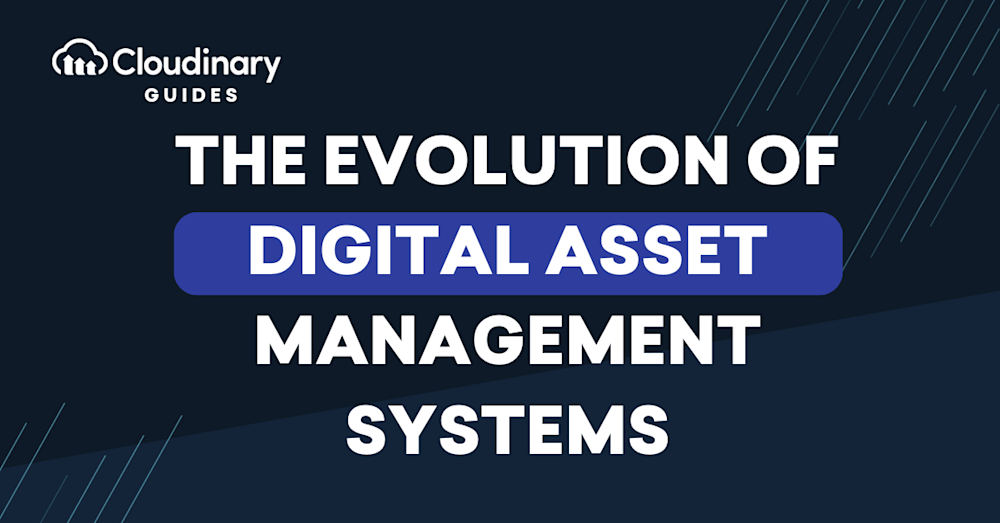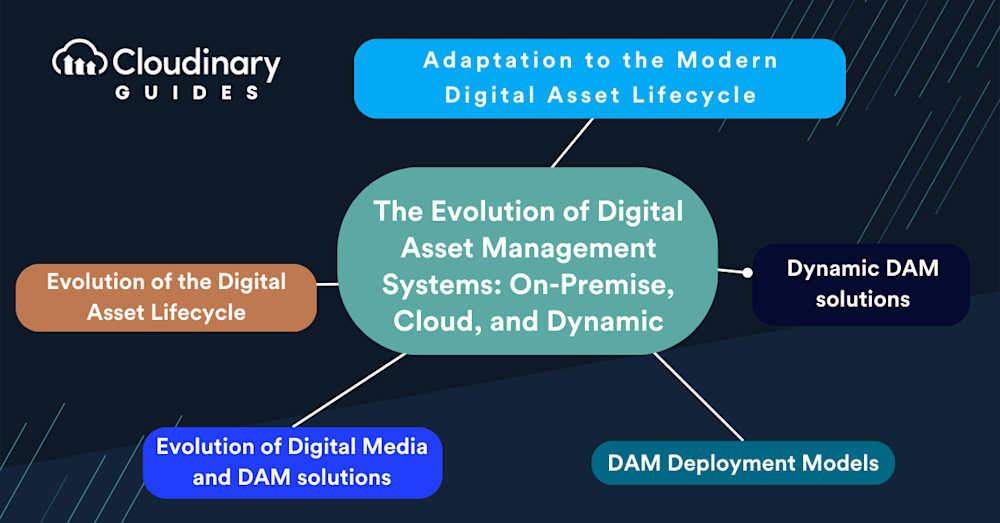Digital Asset Management (DAM) solutions amplify the benefits of rich media, such as images, videos, audio, presentations, and documents, by centrally storing, sharing, and organizing digital assets. Today, images and videos are still trending, and rich forms of 3D and 360⁰ photos and videos are rapidly gaining traction. As dynamic user interactions become more popular, assets are no longer static.
To face these challenges, brands and retailers are searching for new solutions to deploy digital assets to a range of devices. Multiple deployment options are available, including on-premise, public, and hybrid cloud environments.
The digital asset lifecycle, integral to DAMs, encompasses several stages:
- Digital Asset Creation or Acquisition. This is the initial stage where digital assets are either created or acquired. It is foundational to the lifecycle and sets the tone for subsequent steps.
- Digital Asset Approval. Ensuring assets align with brand guidelines and quality standards is crucial before they enter the DAM system.
- Digital Asset Ingestion. This involves importing the assets into the DAM system, often involving tagging and categorizing for easy retrieval.
- Digital Asset Distribution. This stage involves distributing the assets for use across various platforms and mediums.
- Digital Asset Archiving. After their active use, assets are archived for future reference or use, ensuring they can be easily retrieved if needed.
These stages highlight the continuous nature of managing digital assets, emphasizing the need for ongoing management and evolution.
See What is Digital Asset Management guide for a comprehensive introduction.
Evolution of the Digital Asset Lifecycle
In the past few years, the digital asset lifecycle has evolved in significant ways.
Traditional Digital Asset Lifecycle
Traditionally, the lifecycle of digital assets contains four main phases, as shown here:
New Digital Asset Lifecycle
A variety of stakeholders must review and approve media assets to ensure brand consistency. Stakeholders can include creative, marketing, and development teams. Once reviews are complete, media can be processed and delivered.
Effective and dynamic DAM solutions enable these functional teams to seamlessly and efficiently work on assets. This process takes several stages, including collaboration on assets, dynamic manipulation, and dynamic publishing across devices and channels.
Other critical stages in the digital asset lifecycle, which have become increasingly relevant in modern DAM systems, include:
- Reconcile/Audit/Assess. Regularly reviewing and assessing digital assets for relevance, quality, and compliance.
- Iterate/Edit/Change. Continuously updating and revising digital assets to reflect current trends, brand changes, or market needs.
- Deliver/Publish/Share/Distribute. Extending the distribution stage to include publishing and sharing across diverse channels and platforms.
- Store/Archive/Search. Enhancing the archiving process with robust search functionalities to easily locate and retrieve assets.
- Repurpose/Upcycle. Adapting existing digital assets for new uses or contexts, thereby extending their lifecycle and value.
- Retire. Deciding when an asset is no longer relevant or useful and should be removed from active circulation.
Pro Tip
Consider Cloudinary’s Digital Asset Management
Looking for a centralized location to manage all your media assets? Cloudinary’s Media Library makes it easy to upload, store, manage, and deliver images and videos efficiently.
Evolution of Digital Media and DAM solutions
When they first debuted in the 1990s, DAM Solutions played only a minor role in the media stack. The table below describes how those systems have evolved from a niche media-storage tool to an organization-wide enabler over the past two decades:
1990s
Basic Media Library
Brands created digital images primarily for convenience of sharing, followed by printing and deployment as required.
Main focus:
File sharing
Assets:
Videos and photos
Target audience:
Publishing and print companies
2000-2013
Creative Library for Big Brands
DAM vendors added visual content to their storage offering. Some offered specialized Media Asset Management systems.
Main focus:
Management of photos, videos, and visual documents
Assets:
Photos, videos, and visual documents
Target audience:
Major consumer brands and marketers
2013-2018
Marketing Technology
DAM vendors offered integrations with marketing platforms, such as Management Information Systems (MIS), Customer Relationship Management (CRM) tools and Product Information Management (PIM) tools.
Main focus:
Scalable marketing strategies with metadata as a key part of marketing automation
Assets:
Brand visuals, social media, videos, and photos
Target audience:
Marketers, content writers, and eCommerce stores
2018-2020
Dynamic Media Platform
Dynamic, organization-wide DAM solutions manage and manipulate assets, optimizing end-user experiences.
Main focus:
The entire asset spectrum: creation, storage, categorization, manipulation, optimization, approval, search, and delivery
Assets:
Videos, photos, infographics, and documents
Target audience:
Creative, marketing, and development teams; and end-users
DAM Deployment Models
The initial DAM solutions were on premise and stand-alone. The emergence of the cloud offered a much more economical, versatile, and convenient alternative. Nowadays, DAM solutions must manage assets dynamically to satisfy the growing need for asset uploads, sharing, manipulation, and distribution.
On-premise DAM
On-premise DAM solutions are still in use by large enterprises to fulfill regulatory requirements of data storage of graphic files. On-premise DAM software allows organizations to have complete control over all digital assets. It also automates processes, which can lead to significant cost reductions. Some notable on-premise DAM software options include “hyper Content & Digital Asset Management Server,” which allows organizations to have complete control over all digital assets, and “Contentverse,” which offers both cloud and on-prem deployment options with customizable user configurations.
- Total control by IT: In-house IT management and maintenance, including system backups and security updates.
- Stable production environments: In some cases, companies prefer to defer the adoption of certain releases, upgrading them only when deemed necessary.
Cloud DAM
Cloud-based DAM solutions offer many benefits related to cost, speed, scalability, accessibility, and distribution.
- Scalability: Most companies are rapidly accumulating digital assets. Because of their scalability, cloud-based systems are ideal for flexible storage, providing processing power according to your needs.
- Hosting: Systems are web-hosted, making deployment fast and straightforward. The system vendors manage all the upgrades, maintenance, and system backups.
- Security: Public cloud vendors, like AWS, Azure, and GCP, apply multiple layers of security to protect customer data.
- Cost: Typically, cloud DAM solutions are less expensive with no purchases necessary for replacement hardware, software, or storage.
Dynamic DAM
Dynamic DAM solutions enable functional teams to streamline asset workflow, maximize asset value, and optimize visual experiences across all touchpoints.
- Organization-wide collaboration: Creative, marketing, and development teams can collaborate seamlessly on these systems, maximizing the value of assets.
- Cloud-scale architecture: The single-cloud platform provides high performance.
- Extensible APIs: These APIs can integrate with tools like Content Management Systems (CMS), Product Information Management (PIM) systems, and other project-management tools.
- More efficient publishing process: These systems can automate the creation of multiple versions of images or videos with no delays or dependencies.
- Optimization of customer experience: You can customize digital content on these systems for personalized delivery.
Hybrid DAM
In some cases, companies opt for both cloud and on-premise deployments, for example, for storage of financial records on site and marketing material in the cloud.
- Maintenance: The system vendors manage all the upgrades, maintenance, and system backups.
- Cost: With the benefits of the cloud, these systems require a lower budget to run.
- Internet access: These systems are not fully dependent on Internet access, hence no downtime risks during power outages.
The Four Pillars of a Healthy Digital Asset Management Architecture
1. Organized Metadata Taxonomy
A solid foundation is crucial for any stable structure, and for a DAM system, that foundation is an organized metadata taxonomy. This includes controlled vocabularies, file naming conventions, and hierarchical folder structures. Utilizing metadata efficiently sets your DAM program up for long-term success, even as your content volume increases. Proper metadata organization allows for quick filtering, sorting, and searching of assets, which becomes increasingly valuable over time.
2. Defined Roles and Responsibilities
Just as construction projects need specific roles, your DAM program requires clearly defined responsibilities. Identify who will manage the program long-term, govern and expand it, clean and ingest assets, handle special projects, and educate new users. This could be managed by a single person or a team working collaboratively. Clear role definitions ensure smooth operation and accountability.
3. Documented Standards and Processes
In construction, walls and a roof provide structure and safety. In DAM, these are replaced by documented standards, processes, and workflows. These documents outline what is included in the DAM system—whether it’s just final, approved assets or also includes work-in-progress files. Clear documentation helps end-users navigate the system efficiently.
4. The Right Technology
The technology that houses your DAM program is critical. For many organizations, this is a dedicated DAM platform designed specifically for managing digital assets. Each platform offers unique features that can be tailored to meet specific needs. Choosing the right technology is essential; while the best software won’t solve every problem, the wrong one can create new issues. Invest time in selecting a DAM platform that fits your organization’s requirements perfectly.
Adaptation to the Modern Digital Asset Lifecycle
Early DAM solutions were replaced by ones capable of streamlining creative workflows and facilitating collaboration. With modern DAM solutions, you can move digital assets efficiently through an integrated pipeline, from creation to distribution. However, the final frontier—delivery of personalized and optimized assets to end-users—has yet to be perfected.
Visual storytelling is a proven marketing tool; brands tell stories with engaging images and videos, make emotional connections, and inspire users to engage. The brands’ ultimate successes lie not just in asset management, but also in the consistent delivery of personalized and optimized experiences at scale. However, this type of delivery slows down the time to market and raises costs.
Dynamic DAM solutions, which enable cross-team collaboration on a single cloud platform, can be a solution. These systems eliminate functional silos and bridge the gap between asset management and delivery.
Dynamic DAM solutions
To maintain a competitive edge, you must publish media quickly and at scale to websites and mobile apps. You must deliver consistent visual experiences to consumers. Adopting a dynamic DAM system enables you to organize assets before finalizing or publishing, meeting those needs.
An example of a dynamic DAM system is Cloudinary, which offers the following advanced features:
Dynamic image transformations
- Transform images on demand to any format, style, or dimension.
- Optimize images by minimizing their file size without losing quality to accelerate page loads.
- Resize or crop images to match the graphic design of your website or mobile app.
- Optimize the visual quality and compression level of JPEG, JPEG 2000, JPEG XR, WebP, and GIF images.
- Apply image filters and effects.
Dynamic video transformations
- Automatically transcode and optimize uploaded videos for web browsers and mobile devices.
- Embed videos in web pages with HTML5 video tags.
- Stream videos during their encoding phase and deliver them through a Content Delivery Network (CDN).
- Resize and crop videos to match the graphic design of your website or mobile app.
- Rotate videos freely.
Dynamic delivery
- Dynamically adjust image resolution, format, or quality to fit website designs.
- Automatically retrieve media files from remote locations and deliver them through a CDN.
- Resize or crop social media profile pictures and deliver them through a CDN.
- Deliver PDF files, convert them to images, and generate thumbnails.
Artificial intelligence
- Automatically tag media libraries to add metadata for searches.
- Automatically identify appropriate content to facilitate rapid deployment of searchable metadata. Especially useful for media libraries that serve the travel, tourism, and hospitality arenas.
- Automatically pinpoint the primary foreground subjects of photos and remove the background to eliminate superfluous or distracting content.
- Auto-crop images for delivery of different aspect ratios.




